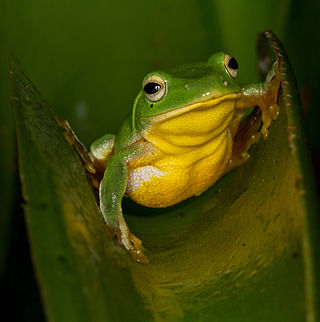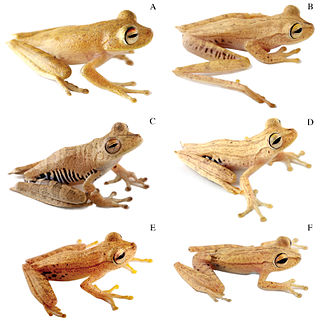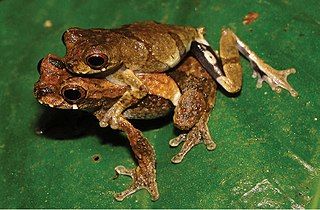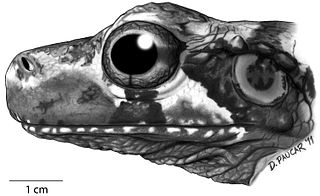
Hyloxalus nexipus is a species of frog in the family Dendrobatidae. It is found on eastern slopes and foothills of the Andes from southeastern Ecuador south to the region of Yurimaguas in Peru.
The Pilalo tree frog is a species of frog in the family Hylidae endemic to Ecuador. Its natural habitats are subtropical or tropical moist montane forests and rivers. It has been observed between 2300 and 2600 meters above sea level. It is threatened by habitat loss.

Troschel's treefrog, also known as the blue-flanked treefrog or the convict treefrog, is a species of frog in the family Hylidae. It is found in most parts of the Amazon Basin including Suriname. Colombian, Guianan and Venezuelan records need confirmation.
Boana latistriata is a species of frog in the family Hylidae. It is endemic to Brazil and only known from its type locality, Itatiaia National Park, and from Marmelópolis, both in the state of Minas Gerais. The specific name latistriata refers to the wide stripes on the back of this frog.

Triprion petasatus, Yucatán shovel-headed tree frog, Yucatan casque-headed tree frog, or Yucatan casquehead tree frog is a species of frog in the family Hylidae found in Belize, Guatemala, Honduras, and Mexico. Its natural habitats are subtropical or tropical dry forests, moist savanna, freshwater marshes, intermittent freshwater marshes, rural gardens, heavily degraded former forests, aquaculture ponds, and canals and ditches.

The Taipei tree frog is a species of frog in the family Rhacophoridae. It is endemic to central and northern Taiwan. It is a medium-sized tree frog; females are 4.5–5.5 cm (1.8–2.2 in) in snout-vent length, and males are slightly smaller 3.5–4.5 cm (1.4–1.8 in).
Boana nympha is a species of frog in the family Hylidae. It is endemic to the upper Amazon basin of southern Colombia, eastern Ecuador, and northeastern Peru; its range probably extends into adjacent western Brazil. The specific name nympha alludes to nymphs, beautiful wood- and marsh-dwelling goddesses in Greek mythology. Common name nympha Amazon treefrog has been proposed for it.
Osteocephalus sangay, also known as the Sangay casqued tree frog, is a species of frog in the family Hylidae. It is found in eastern Ecuador in Morona Santiago province. O. sangay is in the O. buckleyi species group and is closely related to O. cannatellai.
Boana curupi, the yellow-spotted tree frog, fasciated frog or spotted tree frog, is a frog endemic to Paraguay, Brazil, and Argentina. Scientists have seen it between 300 and 700 m above sea level.

Alfaro's tree frog is a frog in the family Hylidae. It is endemic to Brazil, Ecuador, and Colombia. Scientists think it may also live in Peru. Scientists have seen it between 176 and 350 meters above sea level.
Boana nigra, the black-flanked tree frog, is a frog in the family Hylidae. It is endemic to Ecuador. Scientists have seen it between 910 and 1847 meters above sea level.

Dendropsophus kubricki is a frog in the family Hylidae. It is endemic to Peru. Scientists have seen it between 106 and 725 meters above sea level.
Boana cambui is a frog in the family Hylidae. It is endemic to Brazil. Scientists have seen it 905 meters above sea level.
Boana ventrimaculata, the Yasuní tree frog, is a frog in the family Hylidae, endemic to Ecuador and Brazil. Scientists have seen it between 64 and 1035 meters above sea level.

The stained tree frog is a frog in the family Hylidae endemic to Ecuador, Colombia, and Peru. Scientists have seen it between 186 and 354 meters above sea level.

Osteocephalus cannatellai is a frog in the family Hylidae endemic to Ecuador and Colombia. Scientists have seen it between 200 and 1290 meters above sea level.
Boana stellae is a frog in the family Hylidae, endemic to Brazil. Scientists know it from the type locality: between 200 and 600 meters above sea level on the Araucaria plateau in Rio Grande do Sul.
Boana bandeirantes is a frog in the family Hylidae, endemic to Brazil. Scientists have seen it only over 400 meters above sea level.
Boana aguilari is a frog in the family Hylidae, endemic to Peru. Scientists have seen it between 1225 and 2080 meters above sea level.
The tepui tree frog is a frog in the family Hylidae, endemic to Brazil and Venezuela. Scientists have seen it between 420 and 1800 meters above sea level.







